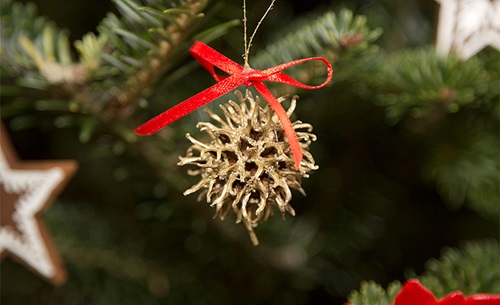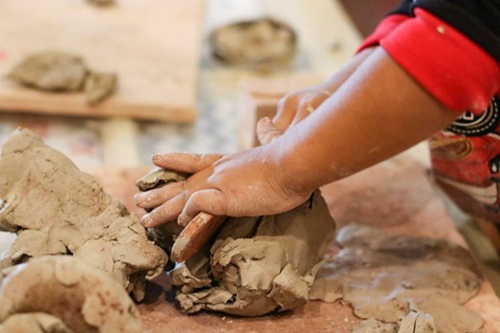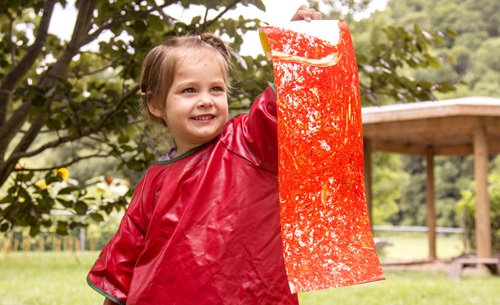Handprint Turkeys, Step Aside:
Embracing Process Art in Early Childhood Programs
| November 2019When my older son was three years old, I went to an “art show” at his nursery school. When I arrived, I was greeted with wall after wall of identical projects. I stopped in front of a display labeled “Whooo is it?” and stared at the rows of perfectly assembled owls, each of which had a lift-up flap with a child’s picture underneath. Families were supposed to guess which one their child had made, but they were all exactly the same. How was I supposed to be able to tell which one was his?
As an early childhood educator, I had a gut feeling that something was off here. Was this what preschool art was supposed to look like? Where was the creativity and self-expression?
That was the beginning of my questioning around how young children should experience art. As cute as some of these projects were, I could not imagine calling them art. My research around the topic introduced me to the terms “product art” and “process art.”
Process art made more sense to me, and a lot of people in the field have long agreed that it is best for young children. In her 1994 book, Preschool Art: It’s the Process not the Product, Mary Ann Kohn wrote, “Young children ‘do’ art for the experience, the exploration, the experimentation. In the ‘process’ they discover mystery, creativity, joy, and frustration. The resulting masterpiece, whether it be a sticky glob or meritorious gallery piece, is only a result to the young child, not the reason for doing art in the first place.”
Lisa Murphy, an early childhood specialist and founder and CEO of Ooey Gooey, Inc., is a strong advocate for abandoning product art entirely. Murphy is passionate about play-based, child-centered early childhood environments. Product art is neither play-based nor child-directed; in fact, these projects are planned by adults and often children are persuaded—even forced—to stop what they are doing to participate. “It violates everything we know about choice, and attention, and play, and whose needs are being met,” Murphy said.
So why do teachers so often default to coloring sheets, making models, and pre-cut projects?
“A lot of the time it is what they know,” Murphy explained. “In many cases, younger people did not get anything close to a developmentally appropriate early childhood education experience.” In turn, many staff entering the field of early childhood education grew up with handprint turkeys, cotton ball snowmen, and theme-oriented projects as a mainstay. Often, they are not hearing that there is a better way.
To move away from product art, center owners and directors need to make a commitment to moving away from non-developmentally appropriate theme teaching and toward what is actually important in children’s lives. Children can then explore their own questions, experience a wide range of materials, and build upon their prior knowledge in a natural way.
It is difficult to commit to process art if you do not understand what it is. Process art focuses on the creating, not what is created. There is no expected result—you are not directing children to make anything specific. In fact, you are not directing children at all; they are directing themselves.
Murphy said, “I believe that true process-oriented art would mean that the children have access to materials on a regular, daily basis that would allow them to be the boss.” When this happens, children are free to choose whether or not they want to keep what results from their experimentation.
With process art, the goal of the experience is the experience. Sometimes, children will create something they would like to keep. But often, they work happily for 10, 20, even 30 minutes at a time, and then walk away without a second glance. When I have open-ended materials freely available in my classroom I see joy, engagement, and creative ideas bursting forth—with no input from adults necessary.
Why Should Process Art Be a Priority?
Why should centers move away from products and embrace process art? The most compelling reason is that process art is developmentally appropriate, and product art is not.
One of the principles of child development identified in the National Association for the Education of Young Children’s 2009 position statement on developmentally appropriate practice is, “Play is an important vehicle for developing self-regulation as well as for promoting language, cognition, and social competence.” All of these areas of development are critical, and as with most skills in the early years, best learned through play. That is why playing with art materials is so important.
Peter Gray, Ph.D., has identified five characteristics of play. The two most relevant to this discussion are: Play is self-chosen and self-directed and, Play is activity in which means are more valued than ends. When you think about art with those characteristics of play in mind, it is clear to see that product art does not have either. When your outcome is determined at the beginning, you cannot experience the same kind of learning.
Gray (2008) writes, “Play often has goals, but the goals are experienced as an intrinsic part of the game, not as the sole reason for engaging in the game’s actions. Goals in play are subordinate to the means for achieving them. For example, constructive play (the playful building of something) is always directed toward the goal of creating the object that the player has in mind. But notice that the primary objective in such play is the creation of the object, not the having of the object. Children making a sandcastle would not be happy if an adult came along and said, “You can stop all your effort now. I’ll make the castle for you.” That would spoil their fun. The process, not the product, motivates them.”
In workshops, I am often asked “Isn’t it okay to do some product art as long as we do process art too?” I think a better question might be, “Why would you do product art? What will children gain from it?”
Murphy suggests asking three questions about anything you are doing in the classroom: What are you doing? Why are you doing it? Who is it for?
When you ask these questions about product art, the answers usually have little to do with child development. You may hear that craft projects are what the program has always done, or that parents want “cute” artwork to display. Quite often, the project relates to the theme of the week. And too often, the theme is not based on the interests of the children or anything that is real and relevant in their lives.
Process art, on the other hand, prompts answers that exhibit child choice, independence, and development in all domains. Process art is all about the children, and what they need. Research has clearly demonstrated how young children learn. Best practices do not support teacher led (and often teacher created) artwork.
When children engage in process art experiences, they talk to each other and adults, wrestle with problems that arise, then solve those problems creatively. They are excited about new information, and often show much more sustained attention. I have observed children who rarely stay with an activity longer than five minutes joyfully dripping paint on paper for more than 20 minutes.
In the realm of product art, there are natural limits to what the children can learn. If a teacher is controlling available types and quantities of materials, such as how much glue children may use, learning is restricted. It is the very act of experimenting that teaches them how much glue is too much, which materials they need to create their own vision, or what the word sticky means.
Change is difficult, and if product art has been used in your program for years, it may take time to change course. The first step is to make the commitment as a program. When I began my current position as a teacher in a parent cooperative preschool program, it was clear that the program had long used product art; there was a whole parent job dedicated to cutting out pieces for the curriculum. I had shared my vision when interviewed, so it should not have been much of a surprise when the curriculum coordinator was bored that year. But with a history that long, and families who had sent older children through the program and thought that those “cute” projects were a symbol of learning, I had a lot of educating to do.
I knew it would not happen overnight, so I made some compromises. I let a parent lead the cherished “dinosaur made out of the letter D” project but did not require children to participate. Slowly, I moved away from these projects, introducing process experiences that parents could observe in action while in the classroom.
Six years later, parents come in with a clear understanding of how I approach art in my classroom. I still have parents who try to stop children from taking supplies off the open art shelf until I tell them, “No, that’s okay. That stuff is for them.” I see raised eyebrows when I tell them the easel is always open. But I hold firm, and when families see their children engrossed in experimenting with art, they begin to understand.
As with any change, it is difficult to shift from what you have always done to a new perspective. But when you understand what young children get from process art—and do not get from activities that focus on the product—the shift makes sense. Watching engaged, excited children splattering paint, learning how to use glue and tape to create sculptures, and communicating with each other as they plan out their next project, you will understand why it is worth it!
If your philosophy already supports using process art over product art, but you are struggling; with staff that continue to focus on product, teachers who stress over the mess, or families asking why they never get any art to bring home; you might need to be more up front from the start.
When hiring staff, let them know you will not be using pre-cut projects. Make sure they understand that they should come to work wearing “play clothes.” Let families know not to expect “refrigerator” art. “There’s room for saying, ‘In this program, this is what we do,’” Murphy said.
My beliefs about art in classrooms have been evolving for years. Though I knew I was not wild about the art my son brought home, as an infant/toddler teacher, I did not think about it much. With infants and toddlers, I would not have even attempted a product art project. When I began to examine art in preschool, I realized that the benefits of process art are much more valuable than those gained through product art.
The results may not look cute on the refrigerator, but they are much more important: creativity, problem solving, collaboration, independence, language development, and social skills—the kind of things that simply cannot be gained by creating the perfect letter D dinosaur.
References
Gray, P. (November 19, 2008). The Value of Play I: The Definition of Play Gives Insights. [Blog post] Retrieved January 22, 2018 from https://www.psychologytoday.com/blog/freedom-learn/200811/the-value-play-i-the-definition-play-gives-insights
Kohn, M.A. (May 1994). Preschool Art: It’s the process not the product. Lewisville, NC: Gryphon House, Inc.
Murphy, Lisa, M.Ed. (2018) Telephone interview, January 18, 2018.
National Association for the Education of Young Children. (2009). Developmentally Appropriate Practice in Early Childhood Programs Serving Children from Birth through Age 8. Retrieved January 22, 2018 from https://www.naeyc.org/sites/default/files/globally-shared/downloads/PDFs/resources/position-statements/PSDAP.pdf
Copyright © Exchange Press. Reprinted with permission from Exchange magazine. All rights reserved. Visit us at www.ChildCareExchange.com or call (800) 221-2864.











